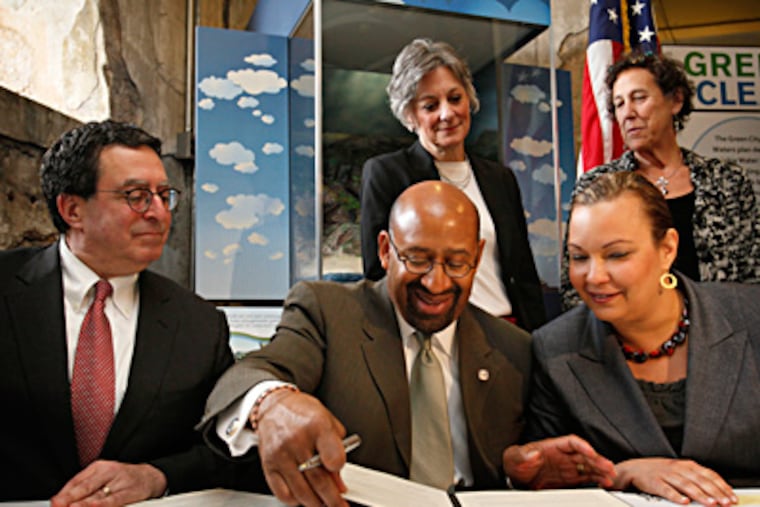Phila. embarks on green stormwater management
Philadelphia's $2 billion plan to manage its storm water with green methods - porous pavement, green roofs, and a plethora of trees - got the official nod Tuesday from the U.S. Environmental Protection Agency.

Philadelphia's $2 billion plan to manage its storm water with green methods - porous pavement, green roofs, and a plethora of trees - got the official nod Tuesday from the U.S. Environmental Protection Agency.
EPA Administrator Lisa Jackson joined Mayor Nutter and other officials at the Fairmount Water Works to sign the agreement for a 25-year plan that has been described as one of the most innovative and ambitious in the nation.
It will transform not only how the city handles storm water - treating it as a resource instead of a waste product - but also how the city looks.
Greenery planted to soak up rainwater will also beautify streets, which could increase property values. Shaded homes will be cooler in summer, which could lower electricity bills. Air quality should improve.
"The city has earned a place as a national and global leader on sustainable innovation and clean water protection," Jackson said at the signing, noting that it was a fitting way to celebrate the 40th anniversary of the Clean Water Act this year.
Dozens of civic and environmental leaders attended the event.
Larry Levine, a water attorneywith the Natural Resources Defense Council, a national environmental nonprofit, called the plan "the most comprehensive green infrastructure program found in any U.S. city."
Others, including Syracuse, Cleveland, and New York, are following Philadelphia's lead, he said.
Philadelphia's problem is that about 60 percent of the city's sewers are a combined system that carries both sewage and storm water.
During heavy rainfall, the system overflows, and untreated water containing raw sewage, litter, road pollution, and other substances spurts from more than 150 overflow pipes into streams and rivers.
The overflows total about 14 billion gallons a year.
Many other large cities have decided to build massive - and hugely expensive - underground tunnels to solve the problem. Washington proposed three of them, the largest eight miles long and 23 feet in diameter.
Philadelphia had considered it, but then realized it might be looking at the wrong end of the pipe. Instead of managing what came out of the sewer system, perhaps it could manage the water before it enters the system.
Officials proposed the plan, "Green City, Clean Waters," in 2009. It wasn't just innovative. It was complicated and lengthy - 3,369 pages. So regulators were wary. Verifying the expected results would take time.
The state approved the plan in 2011. Officials had hoped that federal approval would come by Earth Day that year, but it took 12 more months to analyze the data and conclude that the plan will work.
The approach has won the praise of environmental officials nationwide.
Later this month, the Clean Water America Alliance, a nonprofit water sustainability organization headed by former EPA assistant water administrator Ben Grumbles, will name Philadelphia one of six national 2012 prize winners for its storm water plan.
"This provides hope for communities around the country," Grumbles said of the plan.
He praised the collaboration and partnership aspects, "so that the enforcement agencies don't just feel like this is a leap of faith. They feel like there will be accountability and a way to measure results under the Clean Water Act."
Carol R. Collier, executive director of the Delaware River Basin Commission, said that "what's going to make a difference is actions on the ground, and that's exactly what Philadelphia Water Department is doing."
The city also is pursuing creative funding. It instituted a controversial storm water fee based not on the city water that a building uses - long considered a proxy for what goes down the drain - but on the amount of impervious surface a business has.
The city also has built partnerships with other organizations to green their facilities, bit by bit. For instance, more than 65 green roofs have been installed on city buildings, with 45 more planned.
By Tuesday's signing, the city had built the first 32 "green street" blocks, putting storm water planters near Columbus Square, and installing a tree "trench" along Montgomery Avenue near Blair Street.
Officials have been holding "Soak It Up Philly" celebrations to get out the message. After Percy Street was repaved with porous asphalt, Nutter showed up for the fun. "I poured a gallon of water on the street, and it disappeared."
By year's end, the department expects to begin construction on 215 more blocks.
About 15 parks have been transformed, getting new trees or underground basins to stall and absorb runoff.
Six city schools have gotten greener. The Kensington Creative and Performing Arts High School now has a green roof, an infiltration basin, tree trenches, rain gardens, and porous pavement.
A storm water wetland has been built at Saylor Grove near Lincoln Drive; rain gardens and underground cisterns are a new addition to Liberty Lands Park at North Third and Wildey Streets.
A "depaving" project - converting an impervious parking lot into a porous one - is under way on Eadom Street.
"We didn't just start a revolution," said city water commissioner Howard Neukrug, who championed the idea. He said it was more of an evolution - "one step at a time, figuring out how to redesign the city."